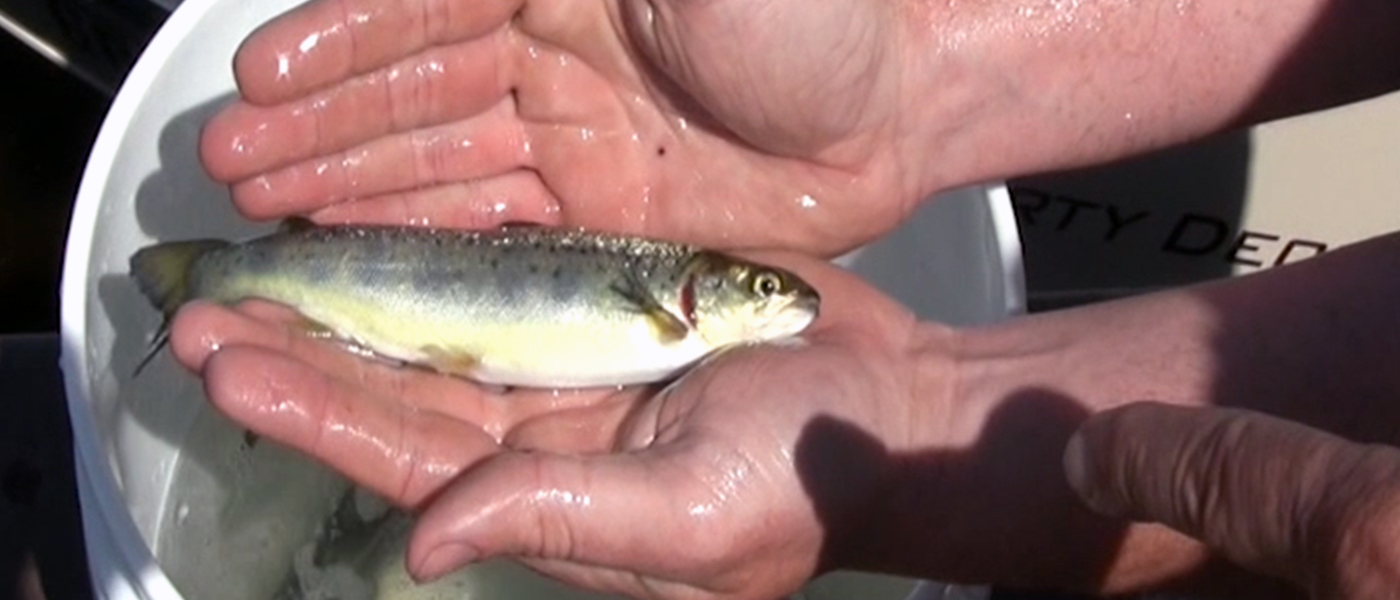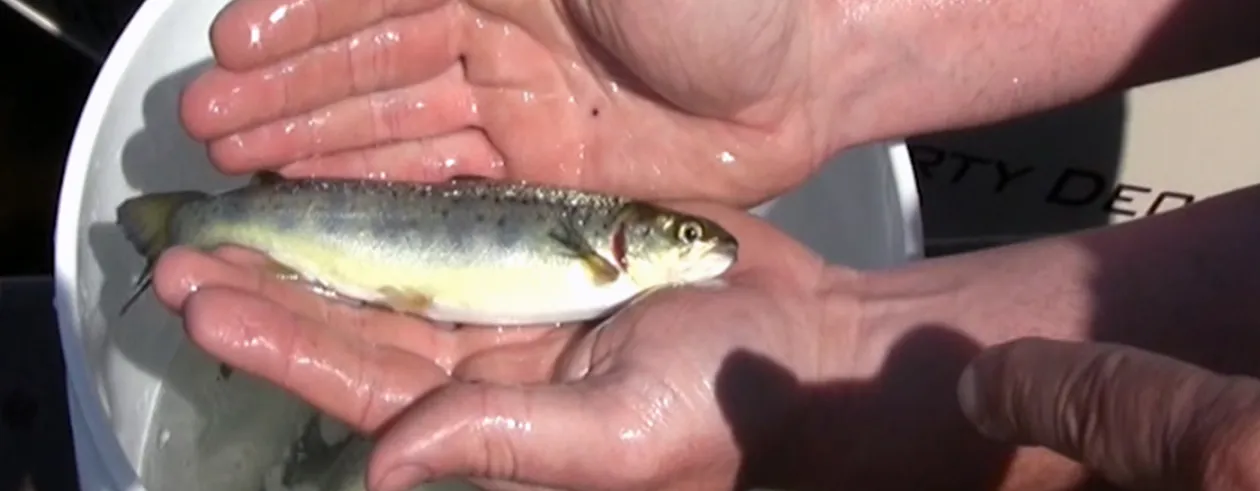
About Landlocked Salmon
Read part one of the Don's Tupper Lake fish stocking journey
A Special Day in Tupper Lake
(Note: the following is the video commentary for the above video.)
“Hi folks! I'm Don Meissner and I'm here on Tupper Lake at the beginning of an incredible fish stocking day. But it's not just any normal fish stocking. Today the DEC is putting 10,000 lake trout and 3,000 landlocked salmon in this lake. And there's a number of volunteers here with their boats to help them so they get these fish disbursed into the deep water first, where they're going to have a lot better chance of survival. You know, this lake is beautiful but what a lot of people don't realize is it's a to fantastic fishing lake. It’s not just the Lakers in the landlocks that are in here, there's all kinds a warm water fish here as well, like walleyes, northern pike and bass. In my mind, if a person was taking a vacation to go fishing someplace, to have this as a backdrop - to be able to stay in this incredible part of the Adirondacks that Tupper Lake is situated in - it's really a fishing dream come true.”
Let’s Talk Salmon

Don: “I’m here with Jack Delehanty, Jack tell us a little bit... first of all, both the species, a lot of people might not know too much, especially the landlocked salmon. What in particular can we pass on to people about this fish: It's appropriateness for this lake, what they need to know about how it's going to survive, and if they can catch them.”
Jack: “Tupper Lake is one of the better kept secrets in the Adirondacks with regard to the amount of forge base in it. We've got a small population here that's astronomical! There's not a place in deep water in this lake that you can't mark smelt on your fish finder, and that's especially true after the thermocline sets up during the summer months in late July, August and right into September. Landlocked salmon need smelt to live, it’s their primary forage base. After they go from eating insects on the surface, they go into the smolt stage: 6 inches to 8 inches and smelt is their primary food source. There so many smelt in here, it’s difficult to catch a fish.”
Don: “Is that right?”
Jack: “There are so many smelt in here every time you catch a fish of any size, six pounds or better, your boat’s going to be a mess from both ends of the fish - whether it be a lake trout or landlocked salmon.”
Don: “Because they regurgitate all the smelt?”
Jack: “They regurgitate the smell, and Donny you know how filthy lake trout are…
“For many years the Department of Environmental Conservation had placed over 10,000 lake trout in here and for a while they stopped putting in landlocked salmon. Through efforts of Rich Preall, who recently retired, and Jonathan the new person over at the Department of Environmental Conservation, it seems that they've come to a consensus that landlocked salmon are good to go in Tupper Lake, and that Tupper is a worthy recipient of that noble fish. More people, I think, who fish deepwater with down riggers, target landlocked salmon as their fish of choice on account of the great aerialists that they are, on account of the fight that they give you, and on account of the fact that you can always bring them to the boat… they’ll shake off if they've got any size to them, so you really have to know what you're doing and it's something to get your heart going.”
Don: “Well, that’s the thing. That’s what fishing is all about. It's about stimulating that excitement that doesn't come in a lot of places and Tupper Lake has it all here. You know, of all the fish I’ve fished, and I have fished all over the continent and gone for every species of fish, the one fish that stands apart to me is a landlocked salmon. And they're not in very many places. It's really tough to find a place where you can really depend on the population to survive, because it is tough for them to survive. The fact that there's so much food for them here… I gotta tell you, you have got to hook a salmon for yourself to understand what I'm saying. When those fish come out in the water, they don’t just come out in the water, they come out at a speed like nothing I’ve ever seen. Of all the fish I've ever caught they just almost rocket across the surface!”
Jack: “They come from depths - when the thermocline sets up here it's about forty-two to fifty-two feet. That’s where the lake stratifies. That is where the most highly oxygenated water is. That's where the smelt are. And when you hook one on a short lead, behind a down rigger, they come great to the surface. We've had them come right out as high as a man stands at the transom with the boat to get a good look at a ten-pounder, and most times it’s gone.”
Don: “See this is what fishing dreams are made of.”
Identifying a Salmon
“You know I'm sitting here beside a bucket of Atlantic Salmon. Who would have ever thought? I sure never thought that this would happen today. But it's pretty interesting because when you look at these fish, they look very similar to a trout, but there's differences. The shape of their tail, the rows of their teeth, and I think it's important for fishermen coming out here to Tupper Lake, to realize, when they catch a fish - just what they're catching. It might seem like a crazy thought to you, but trout and salmon look very similar and the only difference I can really tell you is forget about the teeth, forget about the tail, you hook into one and you'll know immediately: I just hooked into a rocket… it must be a salmon.”
“What we're trying to do is show you what one of these young landlocked salmon look like. They look a lot like a trout, they have the spots and so forth. Is it slimy like a brown trout?”
“It has about the same amount of slime.”
“So this is the size of the salmon that are going to be going in today, you can see how beautiful they are, and it won't be long when this fish will reach 15 to 18 inches, and they become unbelievable!”
Tips for Hooking a Salmon
“I’d like to talk a little bit about what you need to know about catching these fish. This is just a basic, but it's kind of important to know landlocked salmon can be caught near the surface this time of the year because they're going to be chasing smell along the surface especially near the tributaries. And one other way I love to fish for Atlantic salmon is with a fly rod - either a slightly sinking line or a floating line and a tandem Atlantic salmon stream. Here’s two patterns that you've got to remember grey ghost and a green ghost, they’re both fantastic. But let me tell you a little fly that I've got a lot of salmon on, and that is a hornburg. If you’ve never heard or seen a hornburg, look it up in the fly book... I don't know what makes it so appealing to salmon, but they will hit it. Salmon swim fast, they fight incredibly, and I promise you, if you ever can hook into them, you'll be hooked for life because these fish are different than any fish ever caught, and I have caught salmon all the way up into the Arctic really, so I've had a lot of experience catching these fish. But I don't think any of those places can excel what's available here with both lake trout, and now, Atlantic salmon.”
